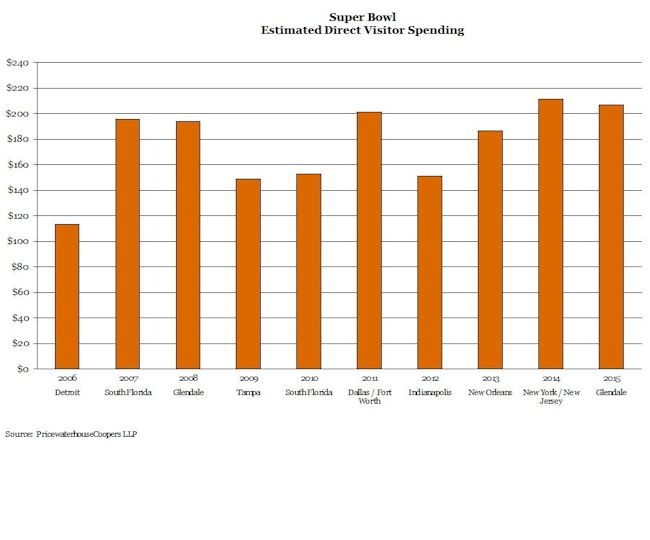NEW YORK, Jan. 26, 2015 — PwC US estimates Super Bowl XLIX will generate approximately $206 million in direct spending throughout the greater Phoenix area by the National Football League (NFL), businesses, visitors, and media. This estimate includes spending on area lodging, transportation, food and beverage, entertainment, business services, and other hospitality and tourism activities. It is based on a proprietary analysis, which considers characteristics unique to this year’s event such as the participating teams, local market attributes, national economic conditions, and scheduled corporate and other ancillary activities.
Excluded from the analysis is the so-called “multiplier effect,” which accounts for “indirect” impacts, such as a concession company’s purchase of goods from local producers and manufacturers, and “induced” impacts, which occur when the income levels of residents rise as a result of increased economic activity and a portion of the increased income is re-spent within the local economy.
The following graphic illustrates, in nominal dollars, the direct spending associated with the Super Bowl since 2006. As shown, the direct spending generated by this year’s event is expected to trail only last year’s Super Bowl held in the New York/New Jersey market.
“This year’s projection is the second highest on record, however the inflation adjusted result is approximately two percent lower than our estimate for Arizona’s last Super Bowl in 2008; the market benefiting that year from pre-recession spending levels and a slightly higher profile game matchup involving a New York market team and the Patriots attempt at a perfect season,” said Adam Jones, director, sports and tourism sector, PwC US.
While its relative impact may not top the 2008 edition, this year’s Super Bowl is the first in an unprecedented series of mega events to be hosted by the Phoenix market over the next three years. This event series, which also includes the CFP Championship in 2016 and NCAA Final Four in 2017, may signal Arizona’s coming of age as a special event destination capable of hosting not only its recurring annual calendar of activity, but rotations of the country’s most high profile events.
Jones further noted, “This year, Super Bowl week will offer a unique test of the market’s maturity as it also hosts the annual Phoenix Open golf tournament over the same week, an event that has continued to increase in scale and impact since the market last hosted the Super Bowl in 2008. While crowding or displacement effects are possible, their effects are likely to be mitigated by the market’s increased hotel supply, air access, light rail system, dispersed geography, and other attributes associated with a well-established winter tourism destination.”



